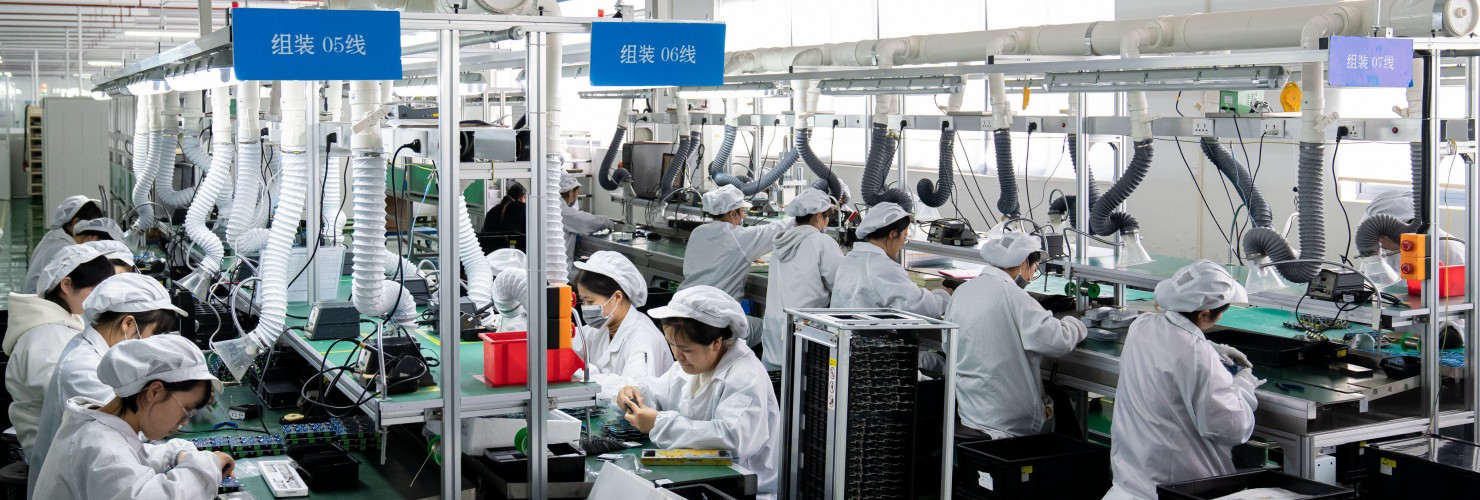

Light industry + metrology + high-tech SMEs
2. Measuring up to the competition: Metrology becomes a tool for self-reliance
At a glance: Six senior policymakers and company leaders have commented on the State Council’s 15-year Metrology Development Plan (the science of measurement), released in January 2022. Led by a statement from a deputy director of China’s State Administration for Market Regulation (SAMR), the commentaries underline the importance of metrology to foster industrial upgrading and technological self-reliance. Key targets of the State Council’s plan for 2035 include:
- Establishing an advanced measurement system based on quantum measurement and a national industrial metrology database
- Breaking through technological bottlenecks in metrology instruments and equipment, especially in new technologies such as quantum chips, the Internet of Things or AI
- Cultivating domestic metrology companies with core technologies and high competitiveness
- Building national industrial measurement and testing centers in strategic emerging industries to support advanced manufacturing
MERICS comment: The niche industry of metrological equipment only recently began to feature in major industrial policy documents. As advanced metrology is required in every step of industrial production, this is set to change.
What really keeps China’s leaders up at night is their dependency on overseas suppliers and the possibility they could be cut off Without access to foreign instruments, certain sectors would quickly face difficulties. For instance, 41 out of 44 Chinese cities with a metro system use operation and maintenance measurement devices supplied by Austrian company NEXTSENSE. A senior Chinese think tanker raises the concern that high-end and core measurement technologies are controlled by foreign countries. Only through metrology – the “seed that breeds science and technology innovation” – can China achieve technological self-reliance, they say.
Foreign companies providing such instruments should expect greater pressure to localize, and in the long-term, more government support for Chinese competitors. For instance, Anhui province has created its own 15-year metrology plan. Here local policymakers are promoting the development of core technologies like magnetic resonance spectroscopy instruments and want to “gradually replace imports”. Foreign companies concerned about protecting proprietary knowledge may resist such pressure to localize if they can determine that there are no viable local competitors.
Article: Give Full Play to the Strategic Supporting Role of Metrology in Enhancing the Core Competitiveness of the Country (充分发挥计量对提升国家核心竞争力的战略支撑作用) (Link)
Issuing bodies: SAMR, CASS
Date: June 1, 2022
3. A spate of new policies support high-tech SMEs
At a glance: Chinese ministries have issued measures to support small and medium-sized enterprises (SMEs), especially high-tech businesses:
- May 31: The Ministry of Finance (MOF) strengthened the preferential treatment of SMEs under government procurement projects, such as by increasing their reserved share of projects
- June 1: The State Administration of Foreign Exchange (SAFE) expanded to 17 provinces from nine a pilot program allowing high-tech SMEs to take on foreign debt
- June 7: The Ministry of Science and Technology (MOST) released guidelines advising SMEs on recently introduced R&D tax advantages, including the 100 percent tax rebate for high-tech SMEs’ R&D expenses
- June 15: MIIT released guidelines for SMEs to be designated as part of a fourth batch of “little giant” enterprises
MERICS comment: Beijing’s rapid roll-out of policies to support high-tech SMEs is both a response to the current economic downturn and part of the PRC’s long-term strategy for SME development.
COVID-19 lockdown measures have been very hard on SMEs in China, and the new initiatives aim to help them ride out the current economic storm. Their effectiveness will likely be limited, as in the past, by systemic challenges. Chinese SMEs suffer from constrained financing, as the state-managed banking sector gives precedence to large enterprises.
The government’s ambition to cultivate specialized, high-tech SMEs in niche markets is by no means a foregone conclusion. The MIIT recently released a fourth batch of “little giant” enterprises, but it is still unclear just how effective this “whitelisting” approach for high-tech SMEs will be. Inconsistent standards applied by local governments have led to a large fluctuation in the companies recognized as “leading specialized SMEs” – the precursor to little giant enterprises – revealing the challenge officials face in directing resources to the most promising firms.
4. Core technologies at the heart of 14th Five-Year Plan for renewable energy
At a glance: The 14th Five-Year Plan to develop the renewable energy sector outlines measures to expand large-scale production, storage and consumption of renewable energy and to support innovation in the field. Nine government agencies headed by the National Development and Reform Commission presented the plan, whose key targets for 2025 include:
- Ensuring renewables make up no less than half of electricity consumption and primary energy consumption added between 2021-2025
- Doubling electricity generation from solar and wind and increasing the national renewable electricity consumption quota from 28.8 percent in 2020 to 33 percent
- Expanding the use of renewables for purposes other than electricity generation, such as via geothermal energy heating, biomass heating/fuel and solar thermal energy
- Strengthening research into frontier and core technologies like high-power wind turbines, high-efficiency low-cost photovoltaic cells and electrolyzer technology
MERICS comment: The goal to derive at least half of additional primary energy consumption for renewables is unambitious. This mainly reflects China’s current concerns about energy security, its primary reliance on fossil fuels in its existing energy mix, and growing energy demand. Even so, the expansion of renewables in the coming years will be significant. Total capacity is forecast to grow by at least 50 percent between 2020 and 2025.
The large-scale rollout of renewables at home will enable Chinese firms to invest more in innovation and strengthen their ability to compete in third markets. China has already developed seven of the top ten wind power equipment manufacturing firms and dominates the photovoltaic supply chain. Now, further government measures to boost talent training, testing facilities, IP protection and so on, will support local champions to master related core technologies.
European manufacturers of renewable technologies need to be ready for increased competition from China in many areas. But as Chinese companies seek to integrate themselves into global innovation networks, there will also be opportunities to collaborate. European firms will be sought out partners in areas where they retain technology leadership, such as in green hydrogen production and storage.
Article: 14th Five-Year Plan for Renewable Energy (关于印发“十四五”可再生能源发展规划的通知) (Link)
Issuing bodies: NDRC, NEA, MOF, MNR, MEE, MOHURD, MOA, CMA, NFGA
Date: June 1, 2022
5. Vocational training plan seeks to avert skilled labor crisis
At a glance: Government agencies launched the Manufacturing Skills Foundation project to strengthen China’s vocational education and training. The project is part of recent policy initiatives such as the 14th Five-Year Plan for Vocational Skills Training. Key targets for 2025 include:
- Establishing several national manufacturing skills training bases that promote cooperation between technical schools and manufacturing enterprises
- Developing a catalogue of government-subsidized vocational training courses focused on “bottleneck technologies” (including robotics, aerospace, etc.) that is regularly updated to reflect actual demand for skilled personnel
- Support manufacturing companies to set up apprenticeship schemes through scholarships, mentoring allowances and other government subsidies
MERICS comment: China lacks millions of skilled workers in key manufacturing industries such as next-generation information technology, electric power equipment and new materials. Prompted by this enduring problem as well as fears of technological dependency, the government has recently amplified efforts to improve vocational training. In 2019, the State Council announced CNY 100 billion in additional funding. Earlier this year, the national People’s Congress passed the revised Vocational Education Law that upgraded the status of vocational education in China.
The new policy itself is not a game changer. For that, structural changes to the vocational education system, such as increasing the time spent at companies rather than classrooms, would be necessary. But it could still help rectify several market failures. Government subsidies for employee training could address the reluctance of employers to invest in their workers due to high turnover or fears of poaching. Such co-funding arrangements exist in countries like Australia or Germany and have already been implemented in some Chinese provinces like Guangxi. Frequent updates to the subsidies catalogue will help to address supply and demand mismatches for workers in high-need sectors.
For foreign companies this is good news. In the long run, these government initiatives might help them find a more skilled workforce. What’s more, foreign companies are often frontrunners in offering apprenticeships, so increased government attention to these issues could raise their profile as good “corporate citizens” in the eyes of the Communist Party.
Article: Manufacturing Skills Foundation Project Implementation Plan (制造业技能根基工程实施方案) (Link)
Issuing bodies: MOHRSS, MIIT, SASAC
Date: June 13, 2022
Noteworthy
Policy news
- June 12: The Intellectual Property Office releases a notice on the implementation of novel intellectual property (IP) regulations, including instructions for using IP to support the financing of SMEs (State Council notice (CN))
- June 13: MIIT announces a list of outstanding robot applications in agriculture, construction, medical care and mining to promote the development of robotics (MIIT notice (CN))
- June 14: The Cyberspace Administration of China (CAC) releases regulations on the administration of apps requiring app providers take responsibility for content monitoring and control (CAC notice (CN))
- June 17: MOST and the National Railway Group sign a cooperation agreement on high-speed rail development to deepen railway scientific and technological innovation (MOST notice (CN))
- June 21: MIIT releases an action plan to improve water efficiency in manufacturing; by 2025 water consumption per value-added should be reduced by 16 percent compared to 2020 levels (MIIT notice (CN))
- June 23: MIIT publishes a list of Internet of Things (IoT) demonstration projects, with 42 in the category of key technology research and 137 in integrated application innovation (MIIT notice (CN))
- June 27: CAC issues new regulations requiring all online platforms and apps implement account verification, personal information protection and other account information management systems (CAC notice (CN))
Corporate news
- May 31: Chinese outlet “The Paper” reports that BYD plans to acquire six lithium mines in Africa, which would secure the car- and battery maker sufficient supplies to make batteries for the next decade (The Paper article (CN); Yicai article (EN))
- June 10: Siemens Healthineers China reveals plans to fully localize production for the Chinese market and to deepen its innovative research and development based in China (Yicai article (EN))
- June 15: BASF announces its joint venture with Chinese battery materials supplier Shanshan, BASF Shanshan Battery Materials, will hike annual production capacity to 100,000 tons for cathode active materials (Jiemian article (CN); BASF press release article (EN))
- June 22: Reports reveal that a new DRAM chip production company, SwaySure Technology Co., Ltd, was launched in March 2022 in Shenzhen with the backing of the Chinese government and expected total investment of CNY 300 billion (Commercial Times article (CN); Computer Base article (DE))
- June 23: CATL unveils its new Qilin EV-battery model which can power a car for up to 1,000 kilometers on a single charge, making it 13 percent more powerful than one planned by Tesla (Sohu article (CN); Caixin article (EN))
- June 28: Chinese automobile industry insiders forecast the auto grade chip shortage will continue through 2023 and 2024, due to the shift to chip-intensive new energy and smart vehicles (Caixin article (EN))

